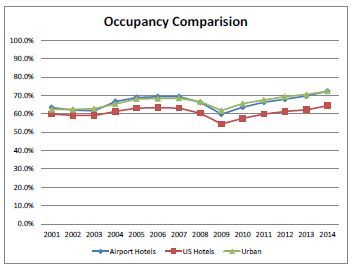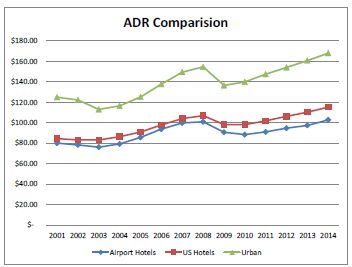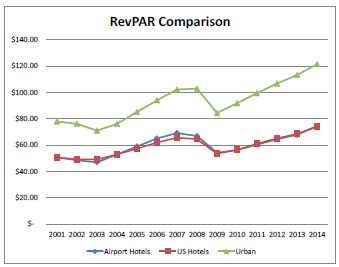By Allison Fogarty
The number and type of hotels that can be supported around airports varies widely by market, and while airline passenger movement is an important consideration, it is not the only hotel demand driver. Local and regional development and transportation patterns also influence the need for accommodations. In some cities, major office submarkets have developed around airports and local business activity fuels much of the local lodging demand. Passengers with early morning flights frequently seek accommodation near airports to avoid traffic delays in congested urban areas or in rural areas where long drives to the airport are common. In addition, major airports frequently serve as central meeting destinations for various groups. And of course, airlines contract for rooms for their crew and passengers stranded due to overbooking or mechanical delays.
Although occupancy levels in airport locations are frequently above the industry average, the ADR in airport locations is frequently somewhat lower than downtown locations or overall industry averages. As a result, the RevPAR of airport hotels as a group is similar to that of the US Hotel industry as a whole.
Hotel developments are under consideration at a number of airports around the country as airport managers seek to diversify revenues and enhance the passenger experience. Airport officials typically seek to balance the interests of a number of constituencies including airlines, local business groups, political leaders and regulatory authorities in developing their master plans which provide a framework to manage growth and development over the next twenty years. As a result, the development process for on-site airport hotels tends to be glacially slow, as airport real estate personnel are required to evaluate in detail the future impact of their decisions, and approvals processes, although they vary by municipality, are invariably protracted.
Issues that airport authorities wrestle with include:
Location: While well-maintained hotels that are physically connected to airport terminals generally achieve higher occupancies and ADRs than their off-site competitors, this locational advantage must be weighed against possible future airport expansion – and the likelihood that a hotel site will be the best location for new terminal gates, runways or other priorities. Several airports proceeding with terminal or runway expansion projects have been forced to reacquire hotel properties in the path of these improvements (frequently at a premium), through eminent domain or buyout negotiations; a process that is easier to contemplate on a thirty- to forty-year-old structure than on one that is still relatively new.
Structure: Hotel developments can be structured in a number of different ways from an ownership perspective; with ground leases and management contracts being the most common. The advantage to airports of a ground lease structure are that the lessee bears the risk of development cost overruns and operating shortfalls; however the development team requires a substantial reward for the assumption of this risk. In addition, the airport must relinquish control of the property for a lengthy period, and financing sources require robust non-disturbance agreements. Conversely, some advantages of airport ownership include long-term control over the asset, shorter management agreement terms and potentially higher returns. If the hotel site is needed for redevelopment, it will be far easier to redevelop an airport-owned property. Airports that own hotels generally contract with a hotel operator to manage the day-to-day operation of the hotel. Since few airports have the internal capability of evaluating, and if necessary, challenging operating budgets, capital improvement plans and marketing strategies, we recommend that airports retain third-party asset managers to oversee the operation. Many airports finance airport-owned properties through airport revenue bonds, which enhance the feasibility of projects through lower debt service. However, airports that finance through revenue bonds are precluded from using the hotel industry’s traditional performance-based management compensation structure, which emerged as an attempt to align ownership and operator objectives.
Procurement Process: Airports generally issue Requests For Proposals (RFPs) incorporating the airport’s standard terms and requirements, along with a brief description of the project. Some airports struggle with RFP development, and provide potential developers with very little information regarding the proposed project and site and minimal guidance in structuring their proposals, thus generating submissions that are difficult to compare and evaluate. During negotiations, we recommend that airports seek specialist legal advice to ensure that important issues are specifically addressed in hotel contracts including maintenance and operating standards, buy-out provisions if the hotel site is required for redevelopment, and interpretation of rent adjustment provisions. Some airports have tied renewal terms to capital expenditures, recognizing that as lease terms expire, tenants have little incentive to maintain the facility and are inclined to “run the property into the ground.”
Oversight: If properties are ground leased the airport is generally not responsible for direct oversight, although well-managed airports will ensure that all lease provisions, particularly with respect to maintenance and operating standards are enforced. Savvy airport managers employ either a staff or third-party hotel asset manager. Effective asset managers have the skill and experience to question operating budgets, annual marketing plans and operating results, and can ensure that renovation funds are spent most effectively.
Hotel facilities are an important amenity around most major airports and for those airports with on premise hotels, overseeing their development and effective operation can be a major challenge. Ensuring that the right team is in place to assist with market analysis, project development and finance, legal advice and asset oversight is a key issue to the short-term success of a project; however it is important to provide some flexibility to allow for unforeseen future needs of the airport, and a mechanism for addressing changing needs or conditions. For an expanded discussion of issues concerning Airport Hotels, please refer to Pinnacle Advisory Groups website at www.pinnacle-advisory.com and click on the article entitled: Airport Hotels: Laying the Foundation for a Synergistic Experience.




